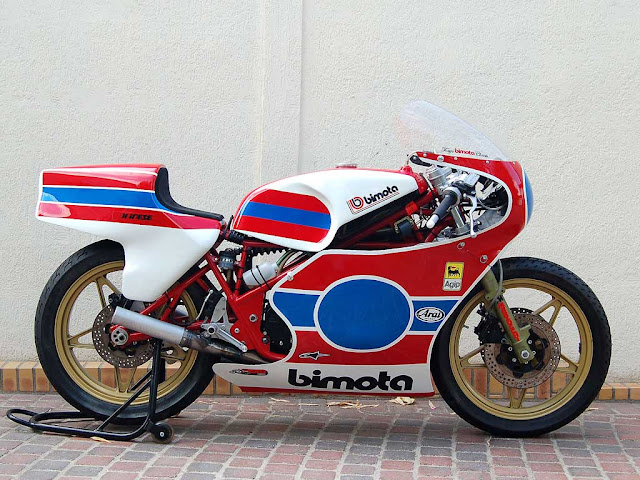Bimota HB2
Thanks to a rigid frame, top quality suspension and light weight, the HB2's handling was in a different league to that of most superhikes.
The Bimota’s full fairing and one-piece tank- seat unit were typically racy touches from a firm with an impressive history’ of grand prix success.
Bimota’s exotic HB2. with its rounded half-fairing, one-piece tank-seat unit, aluminium frame sections and rising-rate rear suspension unit, seemed like a motorcycle from a different planet when it was launched in 1982. The sleek Italian superhike's Japanese rivals were mostly naked fours with steel frames and twin shocks. Even Honda’s mighty CBl 100R was almost old-fashioned by comparison.
The HB2’s initials stood for Honda Bimota. and its engine was the air-cooled. 90lcc twin-cam engine from the Japanese giant’s CB900F. In Bimota style the 16-valve motor was left standard, complete with its bank of Keihin carbs and airbox. although some owners fitted larger flat-slide Mikunis. Bimota's twin-silencer exhaust system saved some weight but barely increased the standard 900F’s output of 94bhp.
The big motor was partially covered by the Bimota's half-fairing, which blended with the one-piece tank-seat unit. (This could be removed after undoing just four bolts plus an electrical connector.) The screen was usefully tall and protective; the view' from the rider’s thinly padded single seat was of a top triple clamp machined from a solid chunk of lightweight alloy.
When the tank-seat unit was removed, the quality of the HB2 became clear. The frame’s visible steel tubes, which ran down to join the alloy plates at the swingarm pivot, were backed up by numerous smaller tubes around the steering head. The aluminium plates at the swingarm pivot provided strength and light weight in that crucial area. A De Carbon rear shock, vertically mounted and operated via a rising-rate linkage, replaced the 900F’s twin shocks. Front suspension was exotic, too: a pair of Ceriani telescopic forks with gold-finished sliders and, at the top of the legs, adjusters that could be turned by hand.
In combination with the Bimota’s reduced weight - at 441 lb (200kg) it was over 70lb (32kg) lighter than the CB900F - that gave a substantial handling advantage. The suspension worked superbly well, giving a taut yet also very comfortable ride. Other high quality parts included five-spoke alloy wheels, produced in the 16-inch diameters that were popular in grand prix racing at the time. The front brake set-up of twin-piston Brembo calipers and drilled 280mm discs was state of the art, as was the fat Michel in rubber.
And the Italian bike was superb in a straight line, too. At low revs the Honda engine impressed with its smoothness and torque, especially with the original CV carbs in place. There were no glitchesor stumbles as the Bimota purred forward at a fearsome rate. Unlike the standard Honda, the HB2 had the fairing and the tucked-in riding position to make cruising speeds of lOOmph (161km/h) or more hugely enjoyable for almost as long as its rider dared. And the HB2 remained impeccably stable as it headed towards a top speed that one magazine tested at 138mph (222km/h).
Fewer than 200 examples of the exotic HB2 were built, plus a further 100 units of its similarly styled successor the HB3, which was powered by the engine from Honda’s CB1100R. The HB3 was produced until 1985, by which time the Japanese manufacturers, too, had introduced fairings, aluminium frames and monoshock suspension. In typical Bimota style, the HB2 had led the way.
Original Bimota: the HB1
Bimota's first ever bike had also been powered by a four-cylinder Honda engine The first HB1 was built from the wreck of the CB750 that Bimota design ace Massimo Tamburini had crashed at Misano. With its racetrack-der ved sty ng and rigid tubular steel frame, the HB1 was a stunningly advanced mach ne when unveiled in 1972. Only ten examples were ever produced.
Specification Bimota HB2 (1982)
- Engine Air-cooled dohc 16-valve four (Honda CB900F)
- Capacity 901cc (64.5 x 69mm)
- Maximum power 95bhp @ 9000rpm
- Transmission Five-speed, chain final drive
- Frame Tubular steel space-frame
- Suspension Telescopic front; monoshock rear
- Brakes Twin discs front; disc rear
- Weight 4411b (200kg)
- Top speed 138mph (222km/h)





















0 comments: